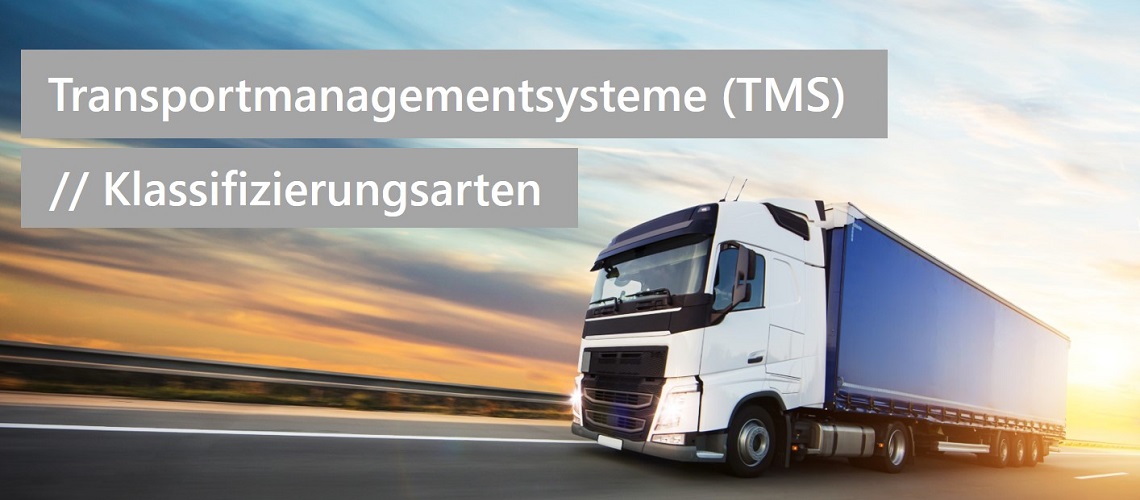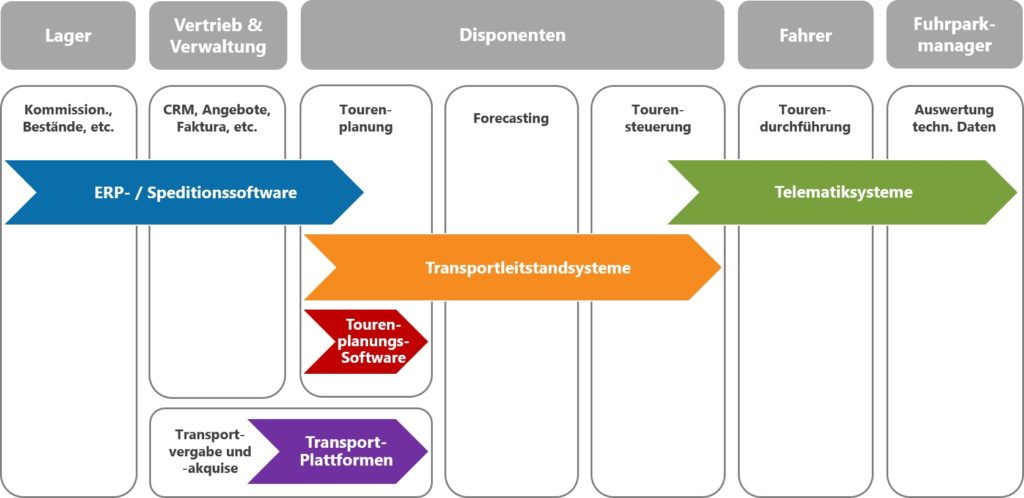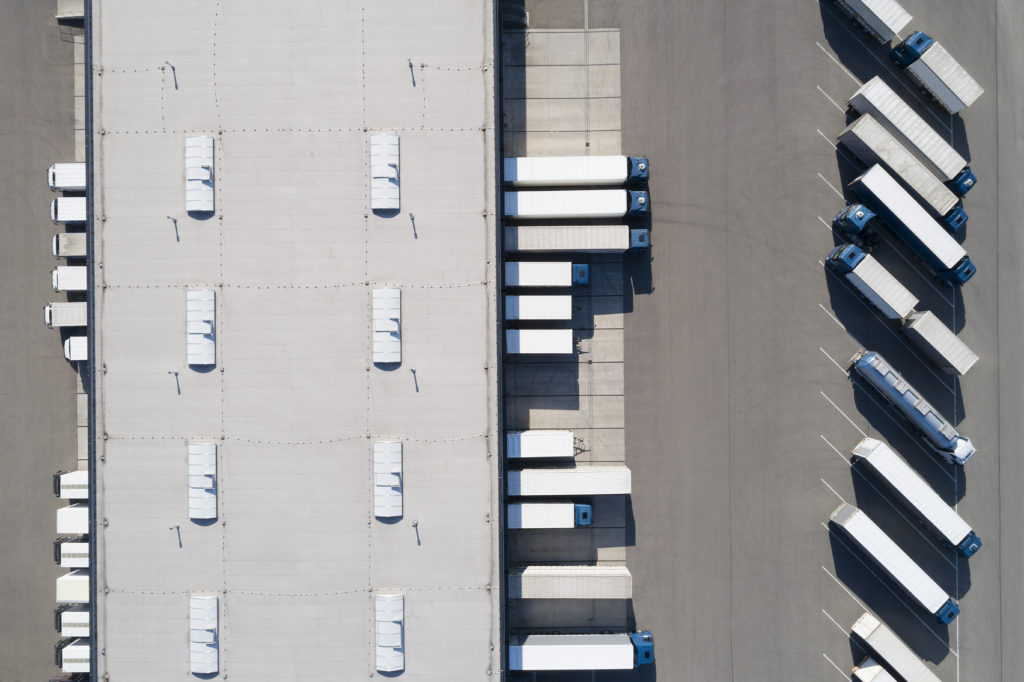
Which truck transport management system is right for me?
The term Transport Management System (also abbreviated to: TMS) is very broadly defined nowadays. The various software solutions offered under the heading of TMS for road haulage differ, in some cases quite considerably, in the functionalities they support. Which system is the most suitable for the user depends largely on the question of which part of the transport process and which user group in the company is to be supported. This article presents a classification into 5 classes of TMS solutions, which should give users a better overview of the systems offered.
Users and departments involved in the process
To classify the different transport management systems, it is first helpful to look at the different employees involved in the transport process. The following directly or indirectly involved groups of people and departments in the company can be identified:
- Warehouse: Is responsible for handling, storage and the timely and complete provision of the goods to be transported. This function does not apply to pure transport companies, as the goods are provided by the consignor.
- Sales & Administration: Create offers and orders and carry out the post-processing, e.g. the invoicing of the service, after the transport has been successfully carried out.
- Dispatchers: Carry out route planning and vehicle or service provider allocation, monitor ongoing transports and must be prepared for unforeseen deviations from the plan.
- Drivers: Are responsible for carrying out the transports planned by the dispatchers. In addition to pure driving, this often includes supporting work during loading and unloading, especially load securing.
- Fleet managers: Are responsible for ensuring that the vehicles are ready for transport in technically perfect condition. They also monitor the ongoing fleet costs, e.g. for fuel, maintenance and repairs.
Five classes of TMS solutions
Based on the groups of people involved in the transport process and their activities, five basic classes of transport management systems can now be identified. Each has a different focus on supporting the tasks involved in the process (see also Fig. 1).
Fig.1: Classification of transport management systems
ERP and freight forwarding software
The administrative tasks in industry and trade are usually supported by ERP systems. They cover processes such as quotation preparation, order management and invoicing, sometimes even up to accounting. Modules for inventory management and warehouse management are also frequently included. Although ERP systems are not usually explicitly designated as transport management systems, they often also contain simple basic functions for route planning and are therefore included in this classification for the sake of completeness.
ERP solutions tailored to the requirements of freight forwarding companies are called freight forwarding software systems. They have existed since the 1990s and can be considered the first transport management systems in the narrower sense. As a central administration system, they should not be missing in any forwarding company. The solutions often also support fleet management, offer interfaces for customs clearance and dangerous goods registration and contain basic functions for route planning and monitoring. However, functions for automating route planning and for the subsequent tasks of transport management, such as forecasting and driver support, are usually missing.
Tour planning software
Route planning software supports companies in planning and optimising routes. The transport orders to be planned are usually taken over from upstream systems such as ERP systems or freight forwarding software. Tour planning systems often use mathematical optimisation algorithms that can automatically create tour plans according to predefined criteria. Monitoring and control of transport execution is often not carried out at all or only rudimentarily in pure route planning systems. In some cases, the solutions do not have their own user interface, but only consist of an optimiser that returns the generated route plans to the upstream ERP or freight forwarding software system.
Transport control systems
The term transport control centre is derived from the production control centres known from industry, which can be used to plan and monitor the production process within a machine park. The transport control centre holistically supports the tasks of the transport planner and thus distinguishes itself from freight forwarding software and telematics systems that focus on the administrative user or the driver as the primary user.
The core functions of the transport control centre are (automated) route planning and scheduling, the monitoring and control of current transports as well as the calculation of the expected development in the next few hours, which is referred to as forecasting. In this context, ETA forecasting, i.e. the calculation of the estimated time of arrival, is becoming increasingly important, as knowledge of the ETA times is particularly valuable for both the customer and the company’s own order picking for the control of further processes.
The continuous inclusion of the driver’s current driving time data plays an important role for both route planning and forecasting. Transport control systems are therefore characterised by close integration not only with upstream ERP or freight forwarding software systems, but also with downstream telematics systems.
Telematics systems
Telematics links telecommunications and information technology. In the context of transport management, this means the transmission of data between the dispatcher on the one hand and the vehicle or driver on the other. Telematics systems usually consist of a mobile application that is operated by the driver and a web-based user interface for the dispatcher to monitor and control the tours. Telematics providers increasingly refer to their solutions as transport management systems and are therefore part of this classification.
Bild: iStock (Bim)
Transport platforms
Transport platforms are not transport management systems in the narrower sense and therefore represent a special class. They support the awarding of transport by an ordering company (consignor or freight forwarder) to a service provider who assumes responsibility for the execution of the transport. The further management of the contracted transport is thus the responsibility of the service provider.
In the meantime, transport platforms are also partly supplemented by shipment tracking functions, so that the client does not have complete control, but at least transparency over the delivery process.
In addition, attention should be paid to the “digital freight forwarders”, most of whom are still operating as start-ups, who have been pushing onto the market with their transport platforms for some years now. However, in contrast to previous market practice, they no longer provide proprietary software, but act as providers of forwarding services themselves. On their online platforms, they match transport requests on the one hand with free transport capacities of the participating transport companies on the other.
Did you like the article? Then I would be happy if you share it with your network using the following share buttons. Thanks a lot for this.
Conclusion
With the help of the classification into five classes, users can make a preliminary selection of the transport management systems that are relevant for them. The central questions from the user’s point of view are:
- Which users do I want to support with the new system?
- Which tasks should be mapped by very comprehensive functions and where is basic functionality sufficient?
- Which solution addresses only what I need, and which one makes me buy much more than I need?



